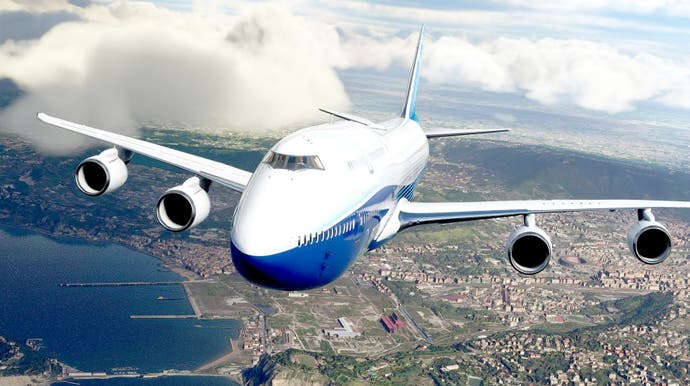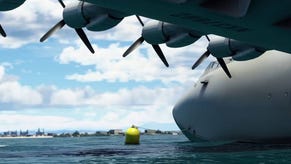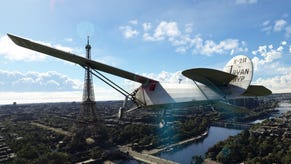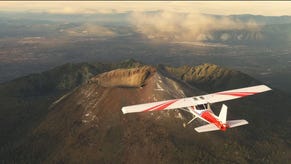How Flight Simulator delivers maximum fidelity visuals
The power of the clouds.
Microsoft's Flight Simulator is every bit as spectacular as we hoped it would be. Footage released to date has highlighted its almost photo-realistic approach to rendering - and yes, the game fully delivers there - but what's more difficult to illustrate is the unprecedented detail level from the macro to the micro level, on a literally global scale. This is one vision for the next generation of graphics: it looks incredible but at a price: be prepared for daunting PC system requirements to deliver anything close to 60 frames per second on its highest quality presets. Flight Simulator will run relatively well on the hardware of today, but it's designed to scale onto the PC components of the future.
Beyond the visuals, what I like about Flight Simulator is the level of accessibility. The basic gameplay is similar to previous series entries, albeit embellished with even more detail and simulation. Flying an Airbus A320 is complex in real life and can be just as complex in the game, but you can scale down the simulation input and automation to a level of difficulty of your choice: the easy mode is great to play with a standard controller, for example. However, the physics and world simulation remains the same, so don't expect it to feel like an arcade game, it's just less 'manual'. The core gameplay loop is simple: it's all about flying from place to place - and that simplicity is the game's strength. For me, at its best, this game is very relaxing - I spent my more than 10 hours with the preview learning how to pilot the plane, exploring the planets and enjoying the sights. I did this for hours on end without really thinking about time - much like you might in the real world while hiking, for example.
At the technological level, the new Flight Simulation is built off of the simulation engine of its predecessor but with extensive improvements and a brand new rendering engine on top, architected by Asobo Studio. That's the developer of the excellent A Plague Tale: Innocence, so it's a studio with a pedigree in delivering bespoke rendering solutions - and the team has truly gone overboard with this one. Delivering the entire world in a game is no mean feat: the engine leverages satellite imagery or fly-by image scans as the basis for height and terrain texture data. An offline procedural generation AI then reads these textures based on their own parameters and properly populates terrain with materials, roads, buildings, bushes, trees and more based on brush set assets the team has made. After this step, the artists can go in and embellish specific locations with even more detail with photogrammetrically captured materials and textures. So, you can expect something a little more lavish with capital cities, specific culture heritage sites or natural landmarks.
When playing the game, you're essentially looking at an extremely high resolution image of the entire globe in 3D - think Google Earth but of a much higher quality. Conceivably, we're looking at multiple terabytes of texture and height map data that you'd never have the hard drive space to store to deliver the achieved effect. The developer's solution is ingenious. This is a simulator and therefore the speed of flight is accurately depicted - and it's rather sedate by arcade standards, of course. Using a base mesh and textures, the game utilises your internet connection to stream even higher quality terrain data onto your PC as you play, via the Azure cloud. It is a novel way to boost the game's fidelity and diversity that I've yet to see in any other release. This is indeed a fully fledged 'power of the cloud' implementation that delivers something that just wouldn't be possible to the same fidelity with a conventional download. It's a system that's also relatively efficient: over 10 hours of gameplay, I noted downloads of around seven gigabytes in total.
It's not just environment detail that's streamed in either. Flight Simulator also accurately renders the real-time world location of actual planes in your vicinity. Weather is accurately simulated based on other real world data too, down to thunder storms and cloud rendering. The aim is to represent real world flight and weather conditions 24/7 - it's ambitious, it's unique and it works. In terms of rendering that weather, the engine delivers near and distant fog, light scattering and cloud volumetric coverage to cover the wide variety of weather scenarios the game presents. Flight Simulator is - obviously - a game about altitude and as around half of the screen is typically rendering the sky, a lot of the rendering budget is spent here.
Massive volumetric cloud formations stretch as far as the eye can see with no visible detail transitions or 'pop in'. Clouds cast shadows onto themselves, onto clouds below them and onto the ground, while they form and dissipate based upon wind and weather conditions. On ultra settings the volumetric clouds are of such a high resolution, the realism is breathtaking. When the atmospheric rendering, clouds and light combine it leads to something very special.
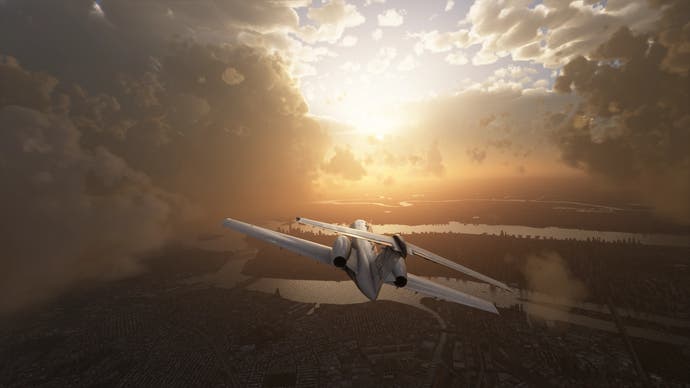
Terrain below the clouds is also given a great attention to detail with bushes, trees, buildings, roads stretching out very far into the distance on the ultra settings. On a technical level, some areas hold up better than others depending on the quality of the satellite data driving them - or whether or not they use streamed in photogrammetric assets, but on the whole most locations hold up beautifully. Flying close to the ground outside of cities reveals highly detailed assets, right down to individual blades of grass. Needless to say, at altitude, the results are almost photo-realistic. Not only that, but the world is not static below you. Cities have their own day-night cycles with rendered cars and buses flowing through their streets, with thousands of light sources and other dynamic elements that all affect the volumetric light rendering in the game. If you fly over a city at night, you can even see the bottom side of your jet or plane being ambiently lit from the glow city below you. Needless to say, the aircraft and cockpit rendering is second to none too. Ray tracing is mooted for a future upgrade and I'm fascinated to see how that pans out.
However, a generational leap in fidelity obvious comes at a cost. On a Ryzen 9 3900X with an RTX 2080 Ti, ultra settings at 4K means frame-rates in 30-40fps territory for most of the time. Variability in frame-rate depends on how close to the ground you are, or how close to the clouds you get. The cloud system, for example, is very heavy on the GPU, while low altitude flying at ultra is more CPU-intensive, to say the least. But fear not, because Flight Simulator scales very well both on the GPU and CPU, based upon various graphics options they offer here.
We'll go into more depth with an optimised settings selection when the game actually launches, but there are some easy wins here. For example, in a completely CPU-limited scenario I could double performance by dropping down to the lowest settings from the highest - so there is definitely some granularity for CPU scaling in these options. At 4K, in GPU-limited situations, dropping from ultra to high settings increased performance by 32 per cent, rising to 61 per cent if you opted for medium settings. I intend to look at each setting in a more granular way, but right now, I think the high preset offers the best visual bang for the buck: the hit to visual quality is minimal and the performance increase is palpable. The internal resolution scaler is also worth looking at - particularly as it may well be using image reconstruction when set to lower than 100 per cent. For a mainstream PC, dropping to 1080p at medium settings saw a Core i5 8400 system equipped with GTX 1060 or RX 580 running in the 30-40fps window, with Nvidia having a very significant 25 per cent performance advantage. I'd hope to see some settings magic from AMD here, as it seems that its Polaris champion is under-performing somewhat.

But the point is that this is basically a next-gen game with a different, more taxing hardware requirement and while the scalability is there to run the game well enough across a range of hardware, you are not seeing it at its best on a mainstream level PC. With that said, like Red Dead Redemption 2 before it, the medium settings here are honestly better than many games out there in terms of the quality of the overall presentation, so it's just as much about scaling your perception of the quality settings with a game where 'medium settings' looks better than many running at ultra.
In my short time with this preview version of Microsoft Flight Simulator, I have seen a level of ambition and craft that is monstrously high. I think the developers have done a good job in terms of graphics scalability (though I really would like to see Nvidia DLSS support for a welcome step-up to performance) but it's important to note that Flight Simulator also stresses your CPU too, something that may improve in the future as the game transitions from the current DirectX 11 renderer to DX12.
But ultimately, what I loved best about Flight Simulator is that it genuinely feels like a PC exclusive. Yes, an Xbox version is coming, but the game is built primarily for the PC and the immense plurality of hardware supported by the platform, something that goes beyond CPUs, GPU, keyboards and mice. I played with a controller, a mouse and keyboard, HOTAS, a flight yoke with pedals - everything. The game automatically recognises each input system and has default mappings for almost everything, just like the great flight sims before it. The flight yoke with pedals and throttle was the best and most enjoyable way to play the game due to how sturdy and precise it is, but even a basic Xbox 360 controller was very relaxing on the easy difficulty setting.
The game maintains this level of support while also being intuitive to customise: you can edit every single thing you can think of in the game view window itself, turning off widgets and moving their location around like an RPG game of old or a military sim. In this respect, it is simply incredible. You can play via a third-person camera, first-person, or you can watch your plane fly around in a free camera with no restrictions, moving multiple kilometres away if that's what you feel like doing. This isn't just a game and I feel that it's much more than a simulator. In more than one sense of the word, this is a journey - and it's a beautiful one.
